Stream Dynamics Open House covered in Silver City Daily Press
Home page story on Stream Dynamics' open house event.
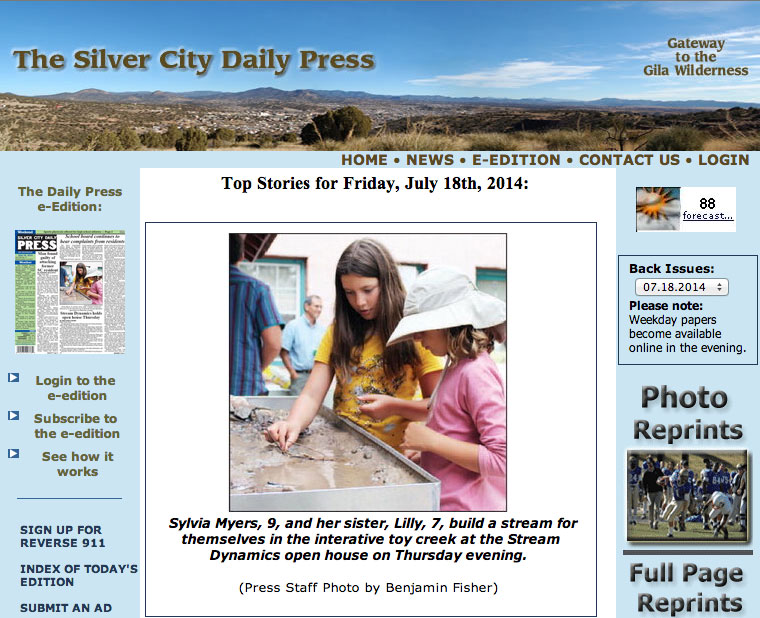
Home page story on Stream Dynamics' open house event.

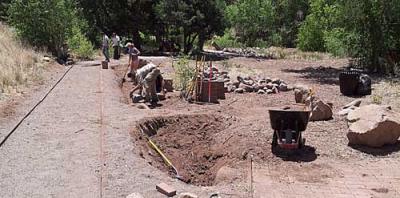 Back in the trees is La Capilla Wetland, picnic tables and hiking paths. Nineteen Youth Conservation Corp (YCC) workers from Aldo Leopold High spent 2.5 weeks improving the water flow from hillsides, Robert St diversions and the Senior Center parking lot into the wetland area witch contains cattails native willow trees and more.
Back in the trees is La Capilla Wetland, picnic tables and hiking paths. Nineteen Youth Conservation Corp (YCC) workers from Aldo Leopold High spent 2.5 weeks improving the water flow from hillsides, Robert St diversions and the Senior Center parking lot into the wetland area witch contains cattails native willow trees and more.
When my kids and I stumbled upon the wetland in 1981 it was a dumping place for trash; there were piles of unused asphalt left over from road paving and piles of discarded broken-up concrete but remarkably lush and green, today it is part of the La Capilla Heritage Park and easily accessed from the Senior Center parking lot although any of the trails around the 23 acre park will take you there.
Sometime in the early 2000's the area was cleaned up, brick paths installed and picnic tables built but the water flows needed more help to get to the actual wetland.
Following a design by Stream Dynamics the group moved a brick path, cleaned out an old culvert, dug a catchment pond, installed a new culvert and many more improvements to the water flows. Above shows the layout for the new path on the left (the old path used to extend straight back from the wheel barrow) and a catchment pond filled by the short culvert under the old section of brick pathway which, when full will now "sheet flood" towards the cattails and willows.
San Vicente Creek Urban Sub-watershed Map (2014), by Andrew Lindlof, Stream Dynamics, Inc & Aldo Leopold High School Youth Conservation Corps.
Presented to the Town of Silver City Floodplain Manager as a GIS layer, it identifies 269 viable water harvesting sites, 96 on town property; there are also 134 treatable chronic sediment supply areas, 69 of these on town property. The GIS data is assessible as a Google Earth KMZ file by clicking on this link.
Stream Dynamics Inc. is busy this month! Check out one of our current projects, with Aldo Leopold High School's Youth Conservation Corps summer crews… They are working on stream restoration, erosion control, and water harvesting construction at the Silver City Senior Center's walking paths at La Capilla Wetlands. Drop by to check out their work sometime soon!
Claire Catlett

In April 15-19, 2014 Stream Dynamics did a gully plug project in a post-fire gully in the North Gullies of Jaramillo Creek in the Valles Caldera. We used whole trees that were cut down as part of a forest stand improvement directed by Bill Zeedyk and Jack Crane. The sawyers were Dwayne and Cory Lefthand from Taos Pueblo. Van Clothier operated an excavator to manouver the trees into the gullies and wedge them in place.
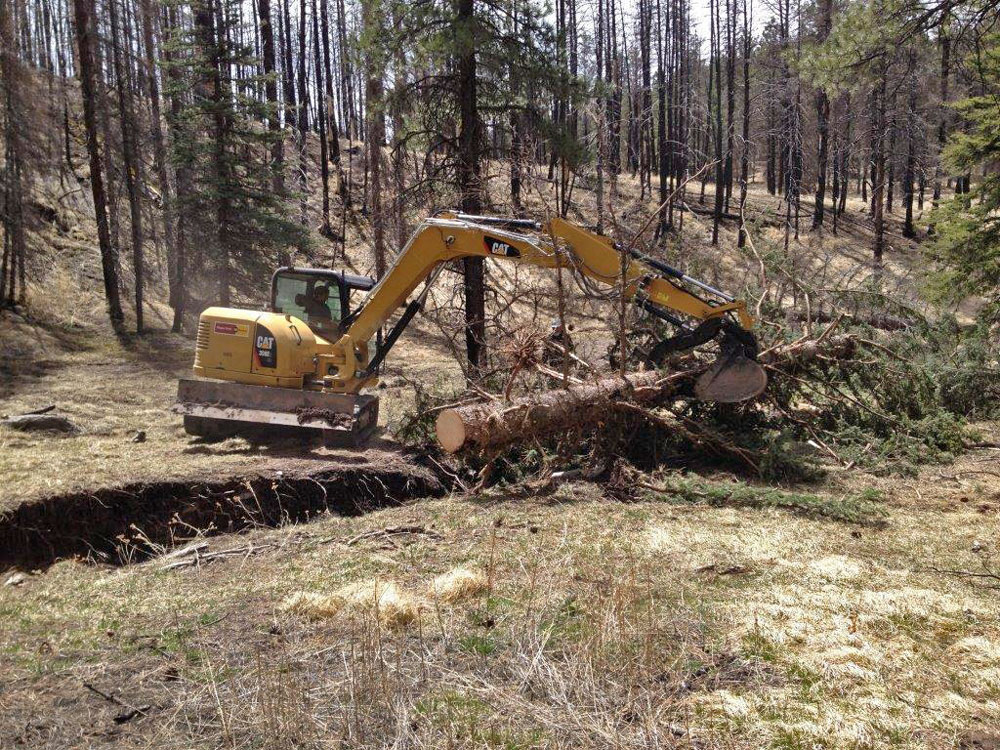
Cat 308 positioning tree in gully.
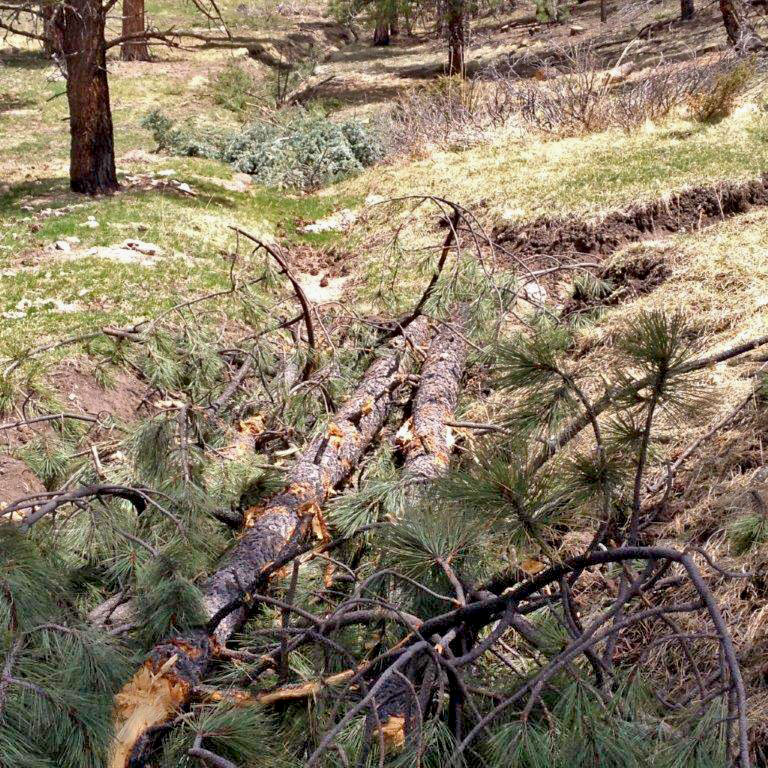
View of several tree length gully plugs in this gully, which will trap sediment and fill the gully back in. This will help keep post-fire sediment out of Jaramillo Creek.
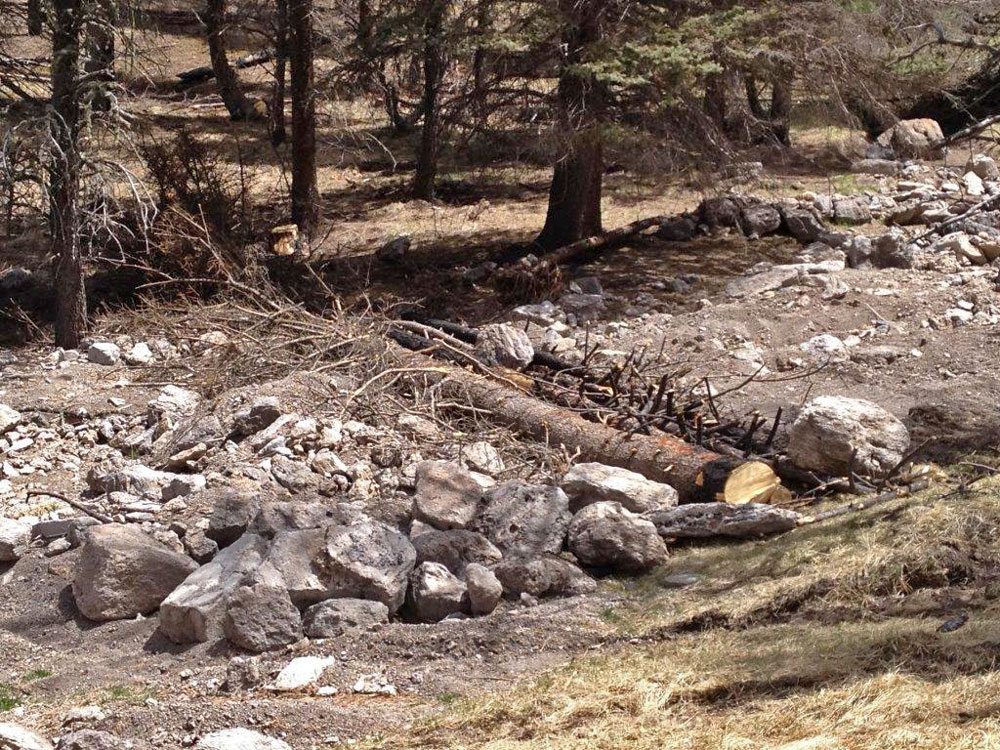
A gully plug and diversion to the original alluvial fan surface will fill in the gully and restore sheet flow and sediment deposition to this natural water-harvesting landform.
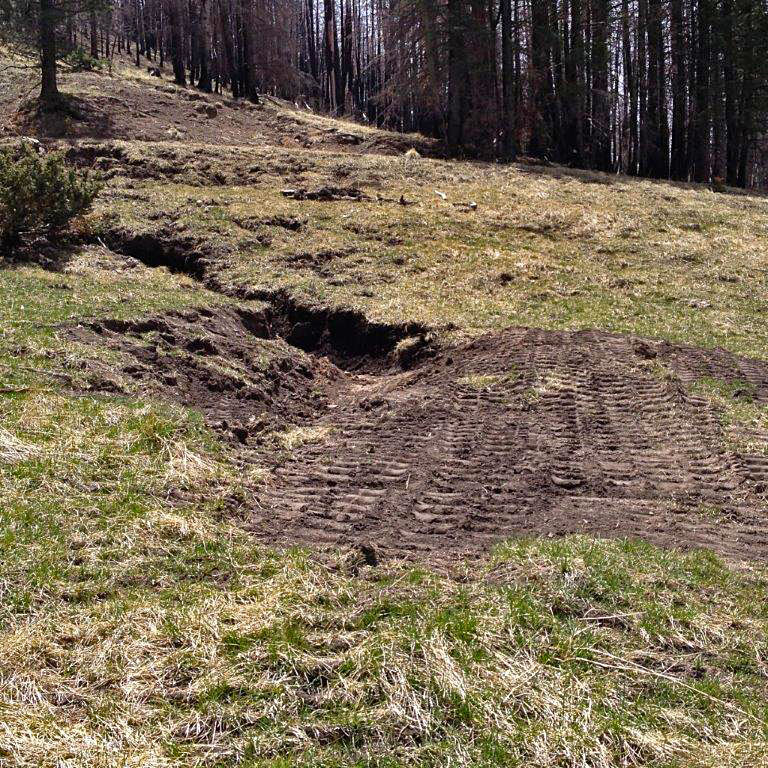
This small gully was caused by the combination of a poorly drained logging road and increased runoff from the burn area upslope. The gully was plugged to create a basin, with the overflow spreding out in the grass. The road above was treated with drainage features as well.
This was done on public land managed by the Valles Caldera Trust. The project was done by Amigos de Valles Caldera, and funded by a grant from the New Mexico Environment Department.
(All photos ©Scott Compton, Watershed Program Manager and hydrologist for the Valles Caldera Preserve)
By Ella Kirk
Imagine a cup of water filled from the tap and brought to your lips only to realize that your glass is empty. Water is so very vital to life, humans and otherwise, that a reliant species without access to it, or to clean supplies of it, would simply crash, no question about it. Water is so vital, but so scarce though it may not seem that way to us. All we have to do is look at a diagram of the Earth’s supply of water to notice that there is not very much available to humans.
I have recently been fighting a diversion of the Gila River here in southwest New Mexico. People ask me why it is so critical to preserve the river. They argue that humans need water and I want to yell at them: Exactly! Here’s how it works: You divert water from a stream or river and the ecosystem and wetlands (which are nature’s purification systems) become degraded to a level where they disappear or no longer support a river system. This creates a situation that is unsustainable because after you degrade the wetlands and stream health, you may be getting a temporary flood of drinking water but because you destroyed the watershed, you will have no water in the future. You are thwarting nature so cleverly only to be rewarded with a system beyond our petty human control that collapses in on itself and us.
Nature is often taken for granted and we don’t realize how much nature gives us. If we let it, Nature could purify a life’s supply of clean water. Instead we work against it and end up stymied. To look at it from an economist’s point of view, Nature is an asset, a tool that we can work with for our own needs if we only took the time to understand the ecosystems we have been swallowing up. Take for example New York in 1997 and its decision about how to purify its water. During the time preceding this decision, NYC was receiving its water from the mountain watersheds in upstate New York, namely the Catskill/Delaware watershed. The water was purified through the wetlands and filtered by the roots of cattail and any excess nutrients received through fertilizer or agriculture were absorbed by flourishing plants. However, as development increased around the watersheds, contaminants began to appear in the waterways. Leaking sewage, pollution from forestry and agriculture, and manure from farms tainted the once pristine NYC tap.
As the once clean water was affected by the relentless development, a cry for action, mainly by the EPA and the commandments of the Safe Drinking Water Act, was instated. New York faced a decision to either invest $6-$8 billion, plus yearly maintenance expenses amounting to $300-$500 million, in an artificial water purification plant OR, and this was a daring idea, spend $1.5 billion on a project to protect the upstate watersheds, that is form buffer zones and protect riparian areas as well as control contaminate amount, where NYC, and most of the state, got its naturally purified water. NY state chose the natural option and began to go about the process of protecting the watersheds that quenched their thirst. Of course, this plan was not smoothly implemented without controversy. Many developers exclaimed that this plan would hurt the economy by prohibiting new property to be developed and new land to be cultivated. Still though, this plan was an enormous success as far as the idea that nature could be an asset goes. But, work does not stop there. I recently heard of a tentative plan to frack in the Catskills and I see how far we have to go.
We want to protect water so we need to protect the zones it inhabits. This is only valid if we slow our growth. For the future of our world, we need to slow growth and switch to renewable energy. We need to revolutionize our current system by huge proportions. In relation to water quality, growth prohibits protection of watersheds because growth is blind. Growth does not care if children die from contaminated water or if species and species of birds go extinct. We can't drink from our rivers at this point, they're just too important. We can lobby in Congress all we want, but in order to do what New York did on a large, every day, viable scale we need to stop our growth and find a system that can support water, which is in serious danger of being poisoned, poisoned by growth. But it won’t be easy to change the consensus of the people and more ominously, the corporations. We need to convince people of the wealth of natural land.
A quote from Orion Magazine puts it this way: “…Typically, the property owners - whether individuals, corporations, governments, or other institutions - are not compensated for the services the natural assets on their land provide to society. With rare exception, owners of coastal wetlands are not paid for the abundance of seafood the wetlands nurture, nor are owners of tropical forests compensated for that ecosystem’s contribution to the pharmaceutical industry and climate stability. As a result, many crucial types of ecosystem capital are undergoing rapid degradation and depletion. Compounding the problem is that the importance of ecosystem services is often widely appreciated only upon their loss.” -Gretchen C. Daily and Katherine Ellison “The New Economy of Nature”, Orion Magazine Spring 2002
Really, the only viable plan is to slow growth because growth in and of itself will make it impossible for planet Earth to sustain us. I have utmost faith that Mother Nature will continue on, plodding through natural selection after natural selection, ice age after tropical oasis shaping a planet out of what it has, as this Earth has always done in the past. Humans are only a minuscule experiment in Nature’s formula for constant change. The Earth will find a way to plod on even through the crude oil sludge that might someday coat our land, but for our own selfish existence, and the existence of our fellow species at this time, we are seriously on the path to mess things up. We our hurling ourselves like suicidal beings against the Earth. We are screwing up our own lives.
But there is still a chance. There is a small space of time to turn ourselves around and try to slow the gears of the machine that is growth and the utter destruction of the planet by mankind. When humankind falls, it won't be a massacre and it won't be apocalyptic-like, with zombies chopping off our heads. It will be the wipe out of our resources, our natural resources. It will be our space overcome by human population crowding out our own selves; it will be food no longer available because all our croplands and forests will have been destroyed; it will be our water, poisoned and diverted until all of it is not accessible or not drinkable. Water is so very vital, I cannot stress this enough. When our hunter/gatherer ancestors ran out of food they knew they had to forage some and move with the animals on migration, but when your water runs out, well, you're in trouble. We can survive 2-3 weeks without food. We can survive a couple days without water.
Water is so special on this planet. It always moves, giving way for more water. It sinks and it spreads. It can dissolve compounds into it, sometimes without a hint to mankind. These attributes make water special and able to sustain organisms, but they also tell a grim fate for those of us who have thwarted the water. When we have piped out all the water from rivers and lakes and the glaciers have melted into the sea, our wetlands will shrivel up and our water will never be clean. When we have contaminated the water, those contaminates, dissolved into the water, will spread and sink into our groundwater, which will be so far deep in the ground from our efforts to unearth we will not be able to reach it.
But I said there was a chance. There is, at least I believe so, if we can look at watersheds as preservers of the peace, as filterers of the water, and as assets to us. Keeping a healthy watershed is bogus without limiting our growth and becoming more sustainable in other ways, just as this limiting and sustainability is impossible bogus without a healthy watershed. The decision in New York to preserve the Catskill/Delaware watershed was small but we can observe the positive repercussions it had. Environmentally, it preserved the wetlands and the animals that live there. This was good for humans, as a selfish species, because it allowed the New Yorkers to get clean drinking water. Economically, it cost way less than the water treatment infrastructure for water that was already coming to NY through the mountains (and could be properly filtered in the mountains). Socially, it was good as well. Humans are all about selfish needs, so this plan is appealing to those needs, because, dear humans, your society will not exist without healthy water. Your society will be sick without clean water. Your social sustainability will be of naught. There will not be a human society after a dozen more decades of water mistreatment.
Though it may be hard to transition to a sustainable lifestyle of limited growth and renewable resources, it's almost mandatory if we want to continue on this planet for a little while longer and leave this good Earth alive, after we our gone.
Now I ask the people who want to divert the Gila River, it is worth the water?
By Ella Kirk
The rain, outside my window, overflows the gutter and splashes into a clump of feather grass. The juniper seems to stretch it's foliage to the gray sky to receive the rain drops that fall. I can practically feel the roots pushing into the wet humus. The air smells rich, like wet moss by a gushing stream.
This is what the desert waits for. All year long, the plants patiently stand through the sparse rains and quaking heat of New Mexico. When winter comes, they absorb the moisture of snow and sleet, but it is not till the monsoons come that the real life springs from the Earth.
In New Mexico, once the monsoons come in early July, we can experience almost daily showers. Often, you see a little stratus cloud in the early morning and by 4 o'clock a massive castle-like, steel-gray thunderhead looms over the sky and cracks open like an eggshell with a boom of thunder, and the rains come streaking down. Monsoons are the times when the grasses are vibrant, when the flowers bloom in their most vivid colors and in the dewy mornings, bird-song is prevalent. From July-September (if it's a good year), the desert of New Mexico gets a wonderful dousing of living things' most revered resource: water.
But what happens to most of that water? We so value that short time when moisture graces us, but a lot of our rain water runs down the streets. If you saw the corner of Yankie Street and Bullard Street in Silver City on the week we had those huge storms, you would know. Why don't we, communities who need water and see so little of it, take advantage of the summer storms?
Cities in the desert are constantly thirsty. We all, living in a dry climate, have a little nagging fear that at some point, our town aquifers might dry up and we would have no water to drink. This fear is what drives us to divert streams and dam up great rivers, just so we can gaze, assured, at the massive bodies of water at our disposal. Maybe, we need not be so afraid. Maybe, instead of using aquifer water to water during rain showers, we could save that valuable ground water for drinking and instead look to another source of water. Not our precious rivers, lifelines for all wildlife, but to another source that comes down by the bucketful in August: rain.
There are many different ways to harvest rain water: tanks that receive the water collected on your roof and gutters, curb cuts that can directly channel storm run-off into your yard, direct flow into gardens, and many other ways, each way customized by who's applying it and what kind of property they are applying it to. There are two basic kinds of rainwater harvesting systems: active and passive. Active systems generally use receptacles or containers of some sort to store rainwater for a later time. These systems can use piping or filtration systems. Active systems are generally more expensive than passive systems. Passive systems divert water through earthworks or non-moving constructions, storing water in the soil rather than in a container.
Whatever system is installed on a property, basic physics, science, math, ecology, and imagination are required for installation. Different land has different slopes and contours, different soil and different uses. Generally, in our area, harvested rainwater is used for watering gardens and landscaping. Especially if native plants are used, rainwater harvesting can be a viable choice for commercial landscaping (or xeriscaping) as well.
When some think of rainwater harvesting, they think of a small amount of water being collected in a bucket and dumped on a garden. Sure this is small scale way of harvesting, but other, more critically engineered ways can produce massive amounts of water. “Even a 2,000 square foot rooftop in the Mojave desert that receives five inches of rain annually experiences over 6,000 gallons of runoff” according to Todd L.Gaston in the Rainwater Harvesting in the Southwestern United States research paper he wrote.Rainwater harvesting can collect a huge amount of water and can be economically as well as ecologically viable.
We live in the desert, a parched region that gets annual monsoons. It only makes sense to collect this resource if we want to continue thriving in Southwestern New Mexico. We can't expect to continue living for much longer if our cities continue to grow and if we don't think of a way to get water. It just makes so much sense. Why water lawns, when you can have Stream Dynamics put in a water-harvesting system? Why pay for water for your garden when you can convert water-not-being-used into a free resource? Rainwater harvesting is beneficial both economically and environmentally.
Sources: Gaston, Todd L. "Rainwater Harvesting in the Southwestern United States." Stream Dynamics Inc., 6 May 2012. Web. 27 Sept. 2013.
Find Stream Dynamics on facebook at https://www.facebook.com/streamdynamics
by Ella Kirk
Water is a unique substance. It's smooth, and slides over our hands, yet can wear away stone and is responsible for many of our landforms. Its solid form is less dense than its liquid form, a great fortune for living things, because if this wasn't true, our oceans would have been frozen solid long ago. Water possesses the property of cohesion as well as adhesion, allowing its molecules to bond to each other through hydrogen bonds and also attract to molecules of different substances, which accounts for capillary action, the force responsible for drawing water out of the roots of plants and into the stems and leaves.
This miracle substance is also one of the best solutes. Almost anything can dissolve in it, allowing particles to be transported quite easily, and often undetectably. This is a curse and a blessing for our modern world.
As easily as water can be contaminated, if you have healthy streams, it can also be cleansed by an area often known as the “kidneys” of a river system: wetlands. These areas are usually rich with reeds and other aquatic plants and teeming with wildlife. Besides, being a great habitat for animals and plants, wetlands are also very effective water filters.
Aside from the miraculous chemical properties and the wonders of its wetlands, water also has a humongous effect on human culture. Most of the biggest cities and oldest establishments were settled near a source of water. Water, and more particularly its flood patterns, made ancient Egypt possible. Water systems, especially large rivers and oceans, unite cultures and made (and still make) transport and trade possible.
H2O, this thirst quencher, makes all life as we know it possible. Water is life, plain and simple. Realizing this, it's astounding and horrific that we don't treat water with more respect. We waste it, we pollute, we dam the systems that bear it, we take it for granted, because we don't realize how lucky we are sometimes.
The other day, my mom told me about how in a village in Nepal, the women walk 3 miles each way, twice a day to bring water from a mountain-top to their homes. On the way up to Albuquerque, we drive by a water park; crystal-clear water sloshes down the brightly-colored slides into pools below. I wonder how many miles the women from Nepal would have to walk to bring that much water home.
It seems sometimes we build our water parks, and our reservoirs, and our glowing lawns with blindfolds on. If we took them off, we would see a desert, where trees bow their heads and pray for rain and the sun bakes down on us. We live in the desert, it's a hard fact for us to ignore, and one that makes it even more crucial to respect water. And we forget, by some small lapse of logic, that being in the desert means we have to conserve more not take more. But it's time for us to remember. It's time for human-kind to rethink their relationship to water.
780 million people world-wide lack access to clean water. We don't know how soon any number of us may join their ranks. If we keep diverting rivers whenever a surge of money comes our way, keep slurping up more and more water from or aquifers, causing the water table to drop so low, wells we dug could hardly reach it, keep manicuring luscious green lawns in New Mexico's June sun, we can not honestly look with unmarred positivity towards our water future. As climate change becomes increasingly real and urgent and our population continues to grow exponentially to an unknown ceiling which means greater water needs, we shouldn't clamber over each other to build the last water park or last lawn. I believe it is time for respect.
I am growing up on the Gila River. Every day I can, I go and sit and watch the cool water as it passes over the rocks in its path. Occasionally I glimpse a beaver along the shore, a deer amongst the willows, a heron wading through the shallows. The water touches all around it with it's gentle hand of life and gives flowers to the wilting shoots, a drink to the thirsty animals, a place where kids and their families can bask in the sun or splash in the shallows. Water grows our food, shapes our land, washes our hair and our clothes, and of course gives itself, pure cold and clean if we're lucky. The fate of water is entwined with our own. It is time we started realizing that.
One of my favorite water -related quotes is by Luna Leopold who says: “Water is the most critical resource issue of our lifetime and our children's lifetime. The health of our waters is the principal measure of how we live on the land.” To me, this encompasses the whole issue of respect. Water is a critical issue, and one that lies at the turning point of our fate. Water is like a report card, it lets us know when an ecosystem is unhealthy.
There is nothing more affected by the damaging practices of industry than water. Water is constantly being recycled, yet its memory can prove infinite. If we poison the water,we poison the fish, the trees, the animals, the plants, the flowers, our communities, the crops, the economy,and ourselves.
But we have a chance. It is said water flows uphill to money, but we must also understand that disrespected water flows downhill to an uncertain future. Water is the blood of the earth, the messenger and I believe it is past time that we stop putting on our blindfolds and gulping down a glass. It's not time to take more water, further compromising future generations. No, it's time more respect. Respect is a two way street. Respect the water, and our flowers will flourish. Respect the water and we are respecting future generations of all species. Respecting water means respecting life.
El 20 de agosto del ano 2013 se cumple un ano de la firma del historico convenio de colaboracion del Instituto Tecnologico Superior de Cananea con Sky Island Alliance, organizacion dedicada a la proteccion de las especies nativas y a la restauracion de sus habitats en la region de las islas serranas.
Gracias a los esfuerzos y a la vision compartida del biologo Sergio Avila e Ingeniero Guillermo Molina, impulsores y gestores de esta alianza, que ha trascendido fronteras en labores de educacion ambiental y en trabajos de restauracion y conservacion en el noroeste de Sonora y suroeste de Arizona.
Durante este período el Instituto Tecnologico Superior de Cananea participo con 51 voluntarios, incluyendo alumnos, docentes y personal administrativo, los cuales representaron 612 horas-hombre trabajadas en seis proyectos de restauracion. Cuatro de estos proyectos se llevaron a cabo en el estado de Sonora teniendo la finalidad de mejorar el crítico habitat ribereno para las aves neotropicales. El resto de los proyectos se llevaron a cabo en el area protegida del canon de Aravaipa, Arizona restaurando las superficies de agua para mejorar la capacidad de retencion de humedad para beneficio de la vida salvaje de la zona.
Así mismo se llevo a cabo un Foro Ambiental en instalaciones del propio Instituto con la participacion de miembros de Sky Island Alliance y voluntarios de nuestra escuela, compartiendo con la comunidad academica los conocimientos adquiridos en distintos talleres, así como sus experiencias vividas en campo.
Finalmente se trabajo a lo largo del ano en multiples jornadas en el area del Pinalito en tareas de restauracion, elaborando estructuras para el control de la erosion logrando estabilizar el arroyo principal, ademas de realizarse el primer levantamiento de inventario de aves y efectuar un monitoreo constante de fauna con camaras remotas.
Este período de actividades ha sido excepcional, su inicio y el consiguiente desarrollo de las tareas han permitido fortalecer el compromiso binacional en la educacion ambiental, conservacion y amistad, alcanzando logros palpables en esta monumental tarea, ademas de dejar gratos recuerdos a quienes formaron parte de ella.
Agradezco al Director del Instituto Tecnologico Superior de Cananea, Ingeniero Pablo Andrade por el apoyo incondicional al proyecto, así como a todos los participantes que hicieron esto posible.
A mi familia, por darle sentido a mi trabajo.
-Guillermo Molina Padilla
Stream Dynamics worked with Sky Island Alliance and volunteers to restore areas aling the Rio Cocospera east of Imuris, Sonora. Here are photos from Fall of 2013.
Human infrastructure sometimes gets flooded if it is built within the flood prone area of the river. Whose fault is this? Mother Nature's?
This photo is from the Gila River at floodstage in late Summer 2013.
On October 15th in Valles Caldera National Preserve, a crew of 4 men from Jemez Pueblo YCC dug a "flow splitter" to re-irrigate a 30+ acre wet meadow that had been drained for agriculture over 80 years ago. This work was done under the design and direction of Stream Dynamics; the client was Wild Earth Guardians.
Here is a LIDAR image of the anthropogenic gullies on an historic alluvial fan in the Valles Caldera National Preserve near Los Alamos, NM. Below is the same image overprinted with labels showing where the work was done. Approximately 38 acres of wet meadow was restored by this work.
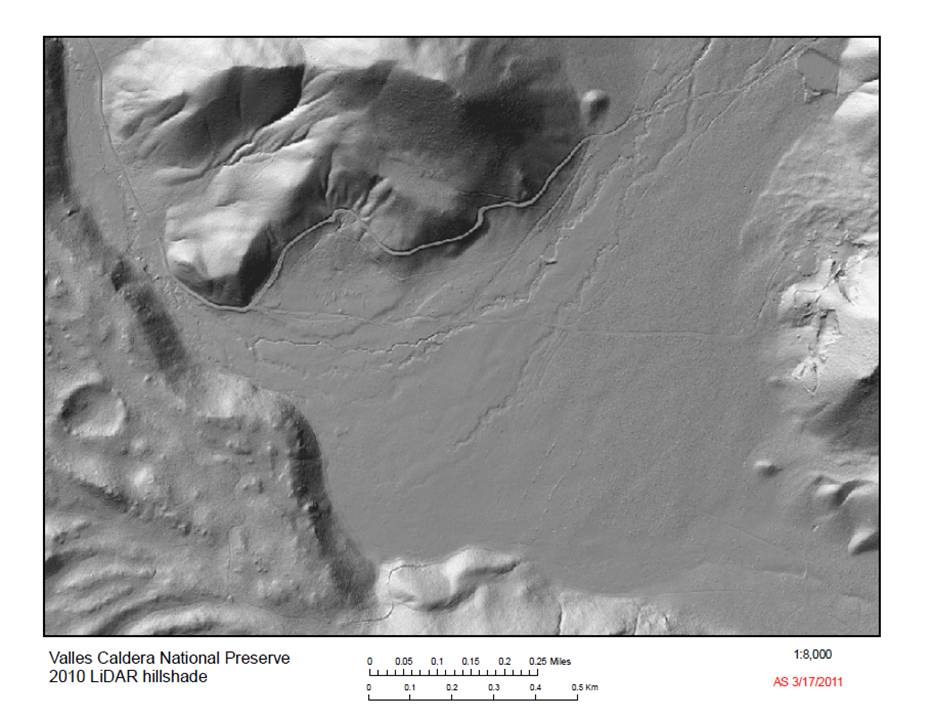
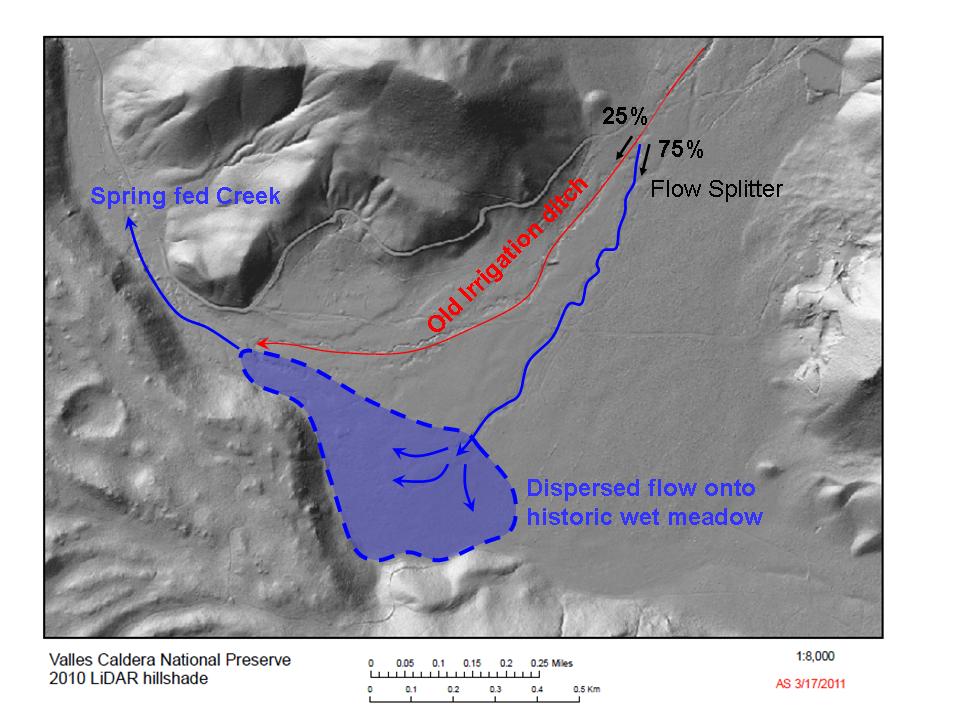
Observe that there is a lot more area that could be converted to sheet flow in a future project. Here is the hand dug flow splitter, sending 75% of the base flow to an historic flow path.
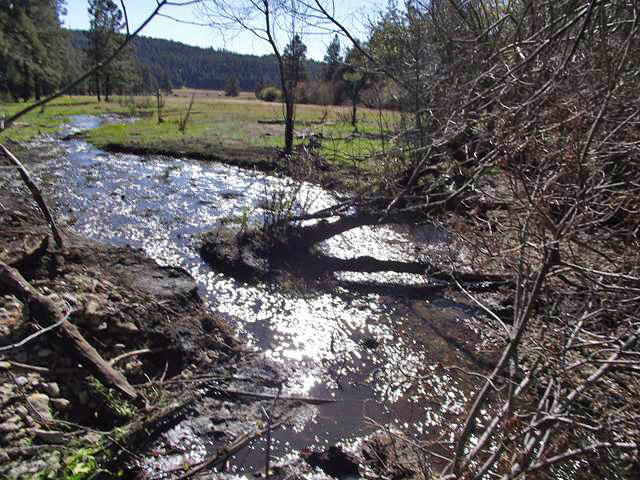
This Gully will now receive only 25% of the flow. A future phase of the project will be to create a series of ponds and meadows here using the Plug 'N Pond technique.
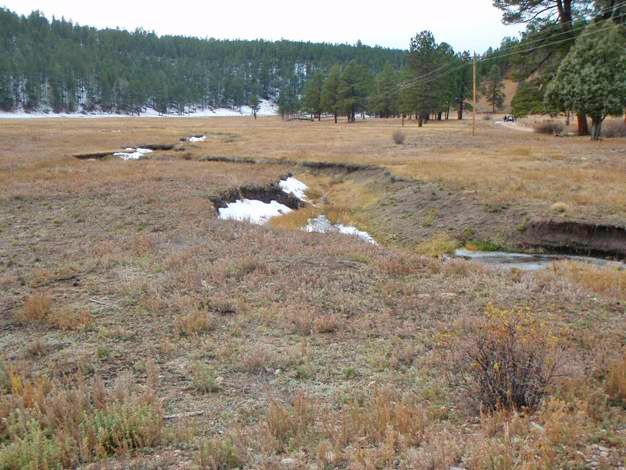
Below is part of the large area that is now becoming saturated as dispersed flow soaks into the ground.
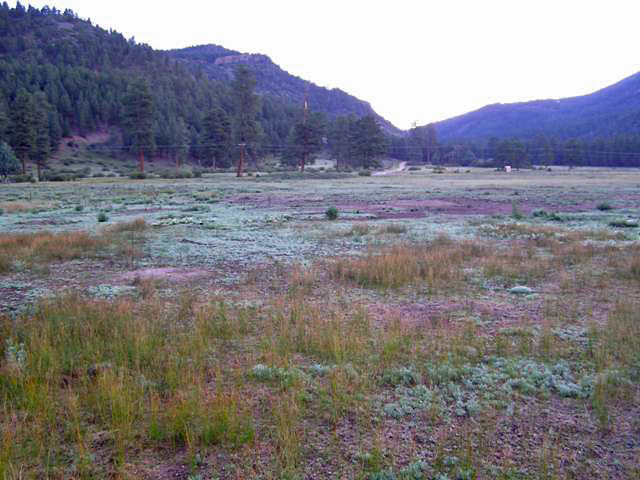
Client: Wild Earth Guardians
Landowner: Valles Caldera National Preserve
Crew: Jemez Pueblo YCC
“All water is connected,” the Lake said. “All water is in constant communication with all other water . . . The waters of the world are one – one consciousness holding the world in liquid embrace. What you do to any part of the waters affects them all.” Starhawk
©2023 Stream Dynamics, Inc.
Site design and maintenance by Sky Jacobs